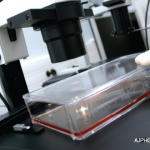In metabolic myopathies defects of glycogenolysis or glycolysis type, glycogen is accumulated upstream, and a lack of lactate rise (on forearm exercise testing) is seen downstream. In disorders of lipid metabolism, there is an increased free fatty acid to ketone ratio upstream, and recurrent hypoketotic hypoglycemia is seen downstream. And in mitochondrial myopathies, elevated serum lactate or lactate to pyruvate ratio is sometimes seen upstream, while mitochondrial proliferation and impaired extraction of oxygen from the blood, manifested by an exaggerated cardiopulmonary response to exercise, are seen downstream.
The most common form of glycogenolytic disorder, McArdle’s disease, has the hallmarks of chronic CK elevation even at rest, and the experience of a second wind about six to eight minutes into moderate aerobic exercise.
In lipid disorders, weakness is seen after long exercise or fasting without cramping or a second wind phenomenon.
Mitochondrial myopathies are marked by exercise intolerance, with extreme fatigue and shortness of breath even at relatively low levels of exertion.
Treatment generally involves changes in physical activity, adjusting diet and dietary supplements. It’s important to keep physical therapy in mind, Dr. O’Rourke said, adding that “the key, however, [is] always balancing the need to avoid disease exacerbation, while at the same time you want to keep them active enough to inhibit disuse atrophy.”
Thomas R. Collins is a medical writer based in Florida.
Second Chance
If you missed this session, it’s not too late. Catch it on SessionSelect.

